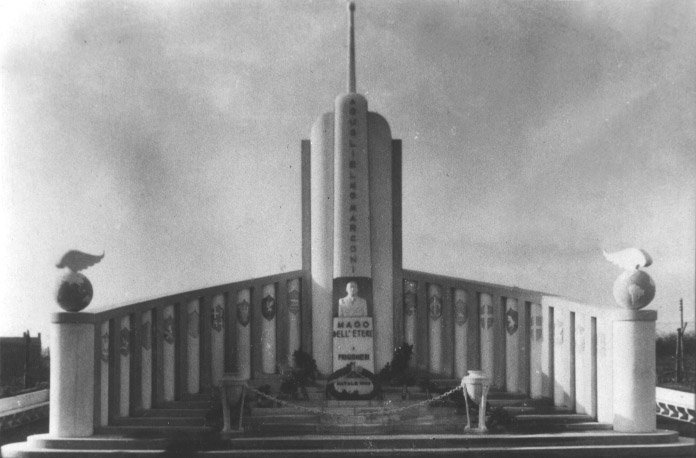The
Italian 'Moni'
by Richard Haworth
Between Broadwell and Coalway, down by the Queensway Housing Estate was a very peculiar construction. It was actually a memorial to Marconi, the Italian inventor of Radio. It stood in the grounds of the old Prisoner of War camp that had been built here during the Second World War. Most of the prisoners incarcerated here were Italians. It was amazing that these men were able to 'find' enough raw materials to create this monument, and with such craftsmanship, despite the obvious hardship of being prisoners in war torn Europe. It would have taken all of their considerable charm to obtain the large amount of concrete and strengthening rods required, and is testimony to how well liked amongst the close knit Forest community these foreigners had become. The elaborate structure was painted to look like pink marble and was festooned with colourful heraldic shields. At its centre was a spire over 20 feet high.


During the Sixties and Seventies it was a favourite haunt of the 'Queensway Gang'. It could only really be explored when the Queensway boys were not about, although we did play with some of them. There was a large open area, criss crossed by wide concrete paths. Some of the long wooden huts still stood, for now, but most had been demolished and burnt, leaving only their concrete bases. The few left were used into the early Seventies by various clubs, Broadwell Boys club being one, and as living quarters for Students working the summer Ribena season at Carter's factory in Coleford. Some of the huts were even squatted in for a while.
Eventually the Queensway Gang demolished the last few. The only thing left standing on the large expanse of concrete wasteland was the extremely battered Moni. This name may have been derived from the Italians themselves, as they called it the Monumento. I can imagine them flamboyantly pontificating about their fabulous "Moni, Moni, Moni-amento'. Then the local kids shortened it (as Foresters do) to the 'Moni', this name then being passed down from generation to generation of children for over 30 years. That is my theory anyway.
However well liked the Italians were, it was not enough to save the Moni. When I knew it, the bust of Marconi (which was said to look more like Mussolini!) had gone, but it did leave a good ledge to sit on, for any child small enough. You could get onto the walls with a good shin up, but the best way up was around the back, where there was a recess like a fireplace. Up this, a wire runged ladder disappeared vertically into the centre of the structure.
This was a very tight squeeze. One of us would be dared to go up. Then we would all stand back to watch whoever emerged, triumphant, but usually covered in filthy black soot. Sometimes, at this point, a Queensway lad would think it hilarious to light a fire in the 'hearth', giving the victim no choice but to dangle over the edge and jump down from its scary heights!
There was one rather solitary lad who spent many hours down at the Moni, wearing a toy Tonka safety hat, wielding a large sledge hammer. It took him months to make a hole in the wall that you could just about clamber through. For why, who knows.
I remember on the day of the Queen's Silver Jubilee in 1977, myself and my best mate Martin heading off early for Coleford and the promised street party. As we passed the Moni, we noticed two or three balloons tied to what was left of the spire. Being dumb adolescents, we started taking pot shots at them with stones. "OYYY!" a voice thundered out "what the bloody hell you doin". It was Cyril Baglin, father of one of our friends. Boy, were we embarrassed! Remembering how hard it was to get up there in the first place made us feel even worse. The thought of some patriotic old boy squeezing up that filthy tunnel, clutching a few measly balloons, only for a couple of 'knobbers' like us to come along and burst them before the Jubilee celebrations had even commenced! We sloped off to Coleford and never mentioned the incident again.
Later that year, what remained of the Moni was knocked down to make way for new houses. If it had survived in its original state, it would have been quite an attraction, but people's opinions were, not surprisingly, very different immediately after the last war. There were, however, a number of Italians from ŒPrisoner of War Camp 61¹ who stayed and settled in the Forest of Dean to start a new life, and new families.
I wonder if anyone remembers any more about the Moni. Please contact forestreunited if you do.
http://www.theforestreunited.co.uk/forest4/the_moni.html
P.O.W. CAMP No. 61 GREAT BRITAIN
